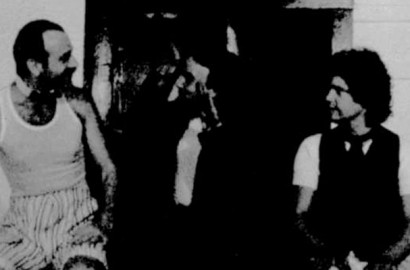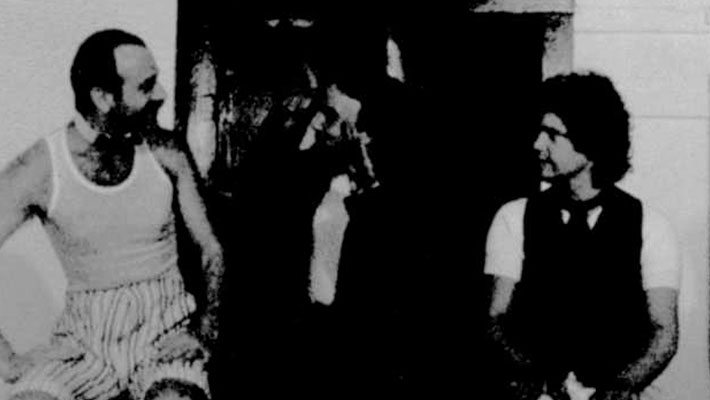Over the next month, we’ll be hearing from our Research Intern Thom Bryce about his experiences tracking down, unearthing, exploring, and cataloguing our 35-year archive of materials from The Rhubarb Festival. We’ll also be launching a new decade of material on our brand new on-line archive.
This week we look at 1979-1989: The Beginning.
The image is slightly blurred, the way all old photographs tend to be. The men’s faces are barely visible. The three stools on which they are perched are pushed close together; they appear to be in front of a plain black door.
It’s Thursday September 26th 2013, and I’ve arrived at Buddies for my first work session as a Rhubarb Research Intern. Exciting! After a detailed discussion with the Festival Director Laura Nanni, I head to the rather imposing filing cabinets in the Board Room, which house the hard copy archival files for the past 34 Rhubarb Festivals.
My first thought is…“Holy crap!” Frankly I’m overwhelmed by the amount of material contained in the archive—and the thought that as a team we’ll be organizing and adding to it over the next four and half months is staggering. Besides sheer volume, the diversity of the types of documents is a lot to absorb. There are press releases, posters, marketing brochures, programs, financial documents, Canadian Actors Equity contract releases, production stills, memoranda, candid photographs, headshots, meeting minutes, artist post-mortem statements, media clippings, and good old-fashioned handwritten notes.
I dig in. In consultation with Laura, I start creating files that will stretch from Rhubarb’s beginnings in 1979 all the way up until this year’s festival. It’s a lengthy but rewarding process. In my third hour, I encounter a small manila envelope with twelve 3.5” x 5” photographs and a number of negatives.
B: Recollect it? I’ve never forgotten it!
C: Me neither!
A: Nor me.
—Ah! But It Sings, But It Sings, Luveena
For some reason, one of these images stays with me during the rest of the itemizing of the archive. It’s a production still from a piece that appeared in the 1980 festival, Fabian Boutillier’s Ah! But It Sings, But It Sings, Luveena. (The full text of the script is available in Franco Boni’s collection Rhubarb-O-Rama!) In the photograph, very young versions of Paul Rapsey, David Ellis, and Sky Gilbert sit on bar stools. They are frozen in poses that seem at once wildly comic and deadly serious: Rapsey and Ellis smile and gesticulate at one another while a befuddled Gilbert looks on, hands on his lap.
Heavily inspired by Dadaism, Boutilier’s play involves three characters, who are only referred to as A, B, and C, discussing “how it is,” or perhaps, uh, how it was “last night” (Boni 27). Contradictory gestures are juxtaposed against phrases that are themselves nonsensical. Meaning in the piece becomes slippery, liquefies, dissolves. The audience is thus forced to examine the process of meaning-making in performance, and recognize how tenuous this process can be.
“Imagine also that the stage is set, the curtains are up but the actors are not yet come. Or the actors are come but there are three green apples on a mantel. There is a quiet expectancy. […] You might grow restless. You might fidget. You smooth your hair. You smooth the skirt of your dress. You smooth your tie. You might get hungry. […] Or you might get angry. You mutter an obscenity. You might even ask for your money back. You can do all that. You are welcome to do all that.”
—Fabian Boutillier, from his Program Note to Ah! But It Sings, But It Sings, Luveena
It’s occurred to me that this is perhaps why I am so drawn to this particular photograph. It isn’t so much that the image generated an emotional charge or feeling for me specific to Boutillier’s play—I’ve never actually seen it performed—but rather that it stands as a metonym for all of the creative energies which have been unleashed by the festival over the years. I think the Luveena photograph has come to represent that for me: 35 years later, Rhubarb is proof positive that passionate artists are still getting up on those stools. In fact, all of the artifacts in the Rhubarb archive speak to those moments when performers begin the delicate negotiation of creating (and perhaps questioning) meaning for, and with, an audience.
That’s why it’s become so important for me that in this, the festival’s 35th anniversary year, we’re able to find a way of allowing patrons to interact with the archive, to find a way of making the archive a type of living library. The archive always speaks. But in its interactions with audience members—that’s when it really sings.
Related posts




I am the Author of Ah But It Sings But It Sing, Luvena. I have only just learned about this article. The article makes mention of a photograph. I wonder might it be possible to get a digital copy of the photograph to add to my collection of personal memorabilia. Regards, Fabian
I work in the archives at the University of Guelph Library and am trying to put a date (year) on a poster from a rhubarb festival. It says: Buddies in Bad Times Theatre and Nightwood Theatre present: ‘Rhubarb!’ It’s a festival! Nov.20-23, 27-30. at the Theatre Centre. New works by : John Berger, Fred Besselink, Late Capitalism, Jerry Ciccoritti, Gregory Corso, Mary Durkan, Sky Gilbert, Cynthia Grant, Amanda Lewis, Flan O’Brien, Linda Pakri, Helen Posno, Kim Renders, Paul Robertson, David Roche, Megan Terry, Maureen White, Tim Wynne-Jones.
Hey Bev,
Without an image of the poster we’d just be guessing, but there’s a great book called Rhubarb-O-Ramma that has complete listings of all Rhubarb shows and artists from that period that will probably give you the info you’re looking for.
But, if it says Buddies and Nightwood, you’re looking at somewhere in the first 5-6 years.